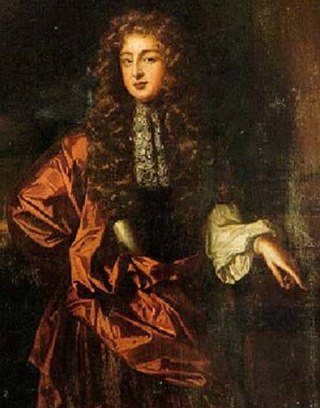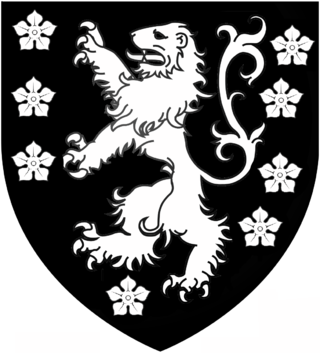
Marquess of Aberdeen and Temair, in the County of Aberdeen, in the County of Meath and in the County of Argyll, is a title in the Peerage of the United Kingdom. It was created on 4 January 1916 for John Hamilton-Gordon, 7th Earl of Aberdeen.
James Hamilton, 1st Earl of AbercornPC (S) (1575–1618) was a Scottish diplomat for James VI and an undertaker in the Plantation of Ulster, Ireland.

The title Duke of Abercorn is a title in the Peerage of Ireland. It was created in 1868 and bestowed upon James Hamilton, 2nd Marquess of Abercorn. Although the Dukedom is in the Peerage of Ireland, it refers to Abercorn, West Lothian, and the Duke also bears four titles in the Peerage of Scotland and two in the Peerage of Great Britain, and is one of only three peers who have titles in those three peerages. The Duke of Abercorn also claims the French title of Duke of Châtellerault, created in 1548.

Claud Hamilton, 1st Lord Paisley was a Scottish nobleman who fought at the Battle of Langside in 1568 for Mary, Queen of Scots. He is the ancestor of the earls, marquesses and dukes of Abercorn.
James Hamilton, 2nd Earl of Abercorn was a Catholic Scottish nobleman. He, his wife, his mother, and most of his family were persecuted by the kirk as recusants. Implementing his father's will, he gave his Irish title of Baron Hamilton of Strabane to his younger brother Claud. His younger brothers inherited his father's Irish lands, while he received the Scottish ones, which he squandered away, being deep in debt in his later days.
George Hamilton, 3rd Earl of Abercorn died unmarried in Padua on a voyage to Rome. He was succeeded by Claud Hamilton, heir of Claud Hamilton, 2nd Baron Hamilton of Strabane, second son of the 1st Earl of Abercorn.
Claud Hamilton, 2nd Baron Hamilton of Strabane was the founder of the Strabane branch of the Hamiltons. He died relatively young at about 32 and his wife, Jean Gordon, married Sir Phelim O'Neill, one of the leaders of the 1641 rebellion, after his death.
James Hamilton, 3rd Lord Hamilton, Baron of Strabane (1633–1655) fought against the Cromwellian conquest of Ireland together with his stepfather Phelim O'Neill. In the Siege of Charlemont of 1650, they defended the fort against Coote, but had eventually to surrender. In 1655 Lord Strabane accidentally drowned in the River Mourne near Strabane, aged about 22 and was succeeded by his brother George.
George Hamilton, 4th Baron Hamilton of Strabane was the younger son of Claud Hamilton, 2nd Baron Hamilton of Strabane. He succeeded to the title in 1655 when his brother drowned while bathing in the River Mourne. After the Restoration, he obtained the return of the family lands around Strabane, which had been confiscated by the Parliamentarians in 1650.

Claud Hamilton, 4th Earl of Abercorn PC (Ire) (1659–1691) was a Scottish and Irish peer who fought for the Jacobites in the Williamite War. He went with King James to Derry in 1689 and tried to negotiate the surrender of the town with Adam Murray. He raised a regiment of horse that he led in the defeats of Newtownbutler in 1689 and Aughrim in 1691. He was killed when the ship that should have brought him to France was intercepted by a Dutch privateer.
Charles Hamilton, 5th Earl of Abercorn succeeded his brother who had been attainted as a Jacobite and, having conformed to the established religion, could get the attainder reversed.

James Hamilton, 6th Earl of Abercorn, PC (Ire), was a Scottish and Irish peer and politician. Appointed a groom of the bedchamber to Charles II after his father's death in battle, he took the Williamite side at the Glorious Revolution and in March 1689 supplied Derry with stores that enabled the town to sustain the Siege of Derry until it was relieved in August. Shortly after inheriting a Scottish and Irish peerage from a second cousin, he was created a viscount in Ireland for his services to the Williamite cause.

James Hamilton, 7th Earl of AbercornPC (Ire) (1686–1744), styled Lord Paisley from 1701 to 1734, was a Scottish and Irish nobleman and peer. An amateur scientist and musician, he published a book on magnetism in 1729 and a treatise on musical harmony in 1730, which was subsequently emended and re-issued by his teacher, Dr. Pepusch.

James Hamilton, 8th Earl of Abercorn PC (Ire), styled Lord Paisley from 1734 to 1736, was an Anglo-Irish peer. He inherited large estates in Ireland, where he built a mansion, and re-acquired some of the family's ancestral lands in Scotland.

Sir Frederick Hamilton was a Scottish soldier who fought for Sweden in the Thirty Years' War in Germany and for the Covenanters in Ireland, Scotland, and northern England. He built Manorhamilton Castle, County Leitrim, Ireland. His son Gustavus became the 1st Viscount Boyne.

Katherine Clifton, 2nd Baroness Clifton, was an English-born Scottish peer.
The Honourable Gustavus Hamilton was an Irish MP.
The Right Honourable Frederick Hamilton was an Irish politician who represented County Donegal in three Irish parliaments. He was also heir apparent to his father, Gustavus Hamilton, 1st Viscount Boyne. He predeceased him but his son succeeded as the 3rd viscount.

Gustavus Hamilton, 2nd Viscount Boyne PC (Ire) (1710–1746) was an Irish politician and an enthusiastic admirer of Italy and the Carnival of Venice.
Thomas Boyd, 6th Lord Boyd (c. 1547–1611) was a Scottish noble and politician.